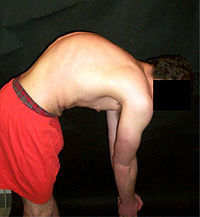
Photo from wikipedia
Purpose Coronal correction errors after medial opening wedge high tibial osteotomy (MOWHTO) occasionally occur even with the assistance of navigation. The purpose of the present study was to determine the… Click to show full abstract
Purpose Coronal correction errors after medial opening wedge high tibial osteotomy (MOWHTO) occasionally occur even with the assistance of navigation. The purpose of the present study was to determine the navigation accuracy in MOWHTO and to identify factors that affect the coronal correction error after navigation-assisted MOWHTO. Methods A total of 114 knees treated with navigation-assisted MOWHTO were reviewed retrospectively. Mechanical axis (MA) on standing radiograph and medial proximal tibial angle (MPTA) were measured preoperatively and at 6 months postoperatively, and the differences (ΔMA and ΔMPTA) were calculated. Joint line convergence angle (JLCA) on supine and standing radiographs was measured preoperatively, and their difference (ΔJLCA) was calculated. To assess the navigation accuracy, ΔMA and ΔMPTA were compared with the coronal correction by navigation (ΔNMA) using intraclass correlation coefficients (ICCs). Univariable and multivariable regression analyses were used to identify factors that affect coronal correction discrepancy (ΔMA − ΔNMA). Results The reliability of navigation was good in terms of bony correction (ICC between ΔNMA and ΔMPTA, 0.844) and fair in terms of MA correction (ICC between ΔNMA and ΔMA, 0.706). The mean coronal correction discrepancy was 2.0° ± 2.4°. In the multivariable analysis, ΔJLCA was shown to be a predictive factor of coronal correction discrepancy (unstandardized coefficient, 1.026; R 2 , 0.470). Conclusion Navigation in MOWHTO provided reliable information about bony correction; however, MA tended to be overcorrected. The difference in JLCA between the supine and standing radiographs was the most important preoperative factor that predicted the coronal correction discrepancy after MOWHTO. In patients with larger ΔJLCA, each degree of ΔJLCA should be subtracted from the planned amount of correction angle when preoperative planning is performed using standing radiographs. Level of evidence IV.
Journal Title: Knee Surgery, Sports Traumatology, Arthroscopy
Year Published: 2019
Link to full text (if available)
Share on Social Media: Sign Up to like & get
recommendations!